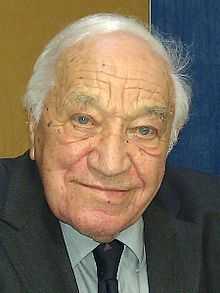John Madin
| John Madin | |
|---|---|
 Madin on 17 March 2011, at the launch of Alan Clawley's book about his work | |
| Born |
John Hardcastle Dalton Madin 23 March 1924 Moseley, Birmingham, England |
| Died |
8 January 2012 (aged 87)[1] Southampton, England |
| Residence | Hampshire |
| Occupation |
|
| Notable work(s) | Birmingham Central Library |
| Home town | Birmingham |
John Hardcastle Dalton Madin (23 March 1924 – 8 January 2012) was an English architect. His company, known as John H D Madin & Partners from 1962 and the John Madin Design Group from 1968, were active in Birmingham for over 30 years. Some of the buildings his company designed have now been demolished, and the now closed Central Library will soon be among them. Societies such as the 20th Century Society campaigned to have some of his buildings listed, but have not achieved this while English Heritage has twice recommended the former Library should be listed, but the attempts were unsuccessful.[2]
Biography
He was born in Moseley, Birmingham on 23 March 1924[3] and died on 8 January 2012.[4]
He served in Egypt with the Royal Engineers in World War II.
Madin was a significant figure of post-war Birmingham architecture. Madin's work has been much neglected and is not highly regarded by the current political leadership within Birmingham. Clive Dutton, the city's former Director of Planning and Regeneration, has described Madin's Central Library as a “concrete monstrosity” (Madin's original plans were for the building to be clad in marble; the city, however, was unwilling to foot the bill so a concrete finish was used instead).[5] A replacement, The Library of Birmingham was opened on 3 September 2013 in Centenary Square, which will result in the previous building being demolished.
John Madin Design Group were also responsible for the early designs for Dawley New Town, which later became Telford. During the 1970s, Madin became increasingly involved in master-planning projects in the Middle East.
Since Madin's period of dominance in Birmingham there have been very few architectural practices able to match his commercial success at home and abroad. Only Associated Architects and more recently Glenn Howells have approached Madin in this respect.
Works
Notable buildings
- AEU Building, Smallbrook Queensway, Birmingham (1955, demolished 2005)
- Chamber of Commerce and Industry, Birmingham (1958)
- The Post and Mail building, Birmingham (1960, demolished 2005)
- Birmingham Central Library (1974)
- Neville House, Hagley Road, Birmingham (1977)
- Shell Mex and BP House, Edgbaston, Birmingham
- BBC Pebble Mill, Birmingham (demolished 2005)
- West Bromwich Police headquarters (demolished January 2012)
- Redditch Central Library
- The Sandwell Centre, West Bromwich
- Metropolitan House, Five Ways, Birmingham
- Powergen, Shirley, Solihull
References
- ↑ Tributes pour in for Birmingham's brutalist architect John Madin, Birmingham Post, retrieved 12 January 2012
- ↑ "John Madin". The Daily Telegraph. 12 January 2012.
- ↑ Clawley, Alan (2011-03-17). John Madin. Twentieth Century Architects. RIBA Publishing. ISBN 978-1-85946-367-3.
- ↑ John Madin dies
- ↑ Birmingham reveals new library plans - Building Design
External links
| Wikimedia Commons has media related to John Madin. |
- John-Madin.info, a website with comprehensive information and photos (including a 132 page illustrated PDF of his life and work)
- Interview and background; July 2005
- Interview, 10 August 2005 in The Guardian.
- Chamber of Commerce and Industry building
- BBC Documentary, 1965